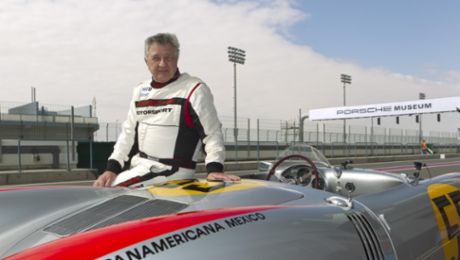The 993 was the fourth iteration of the 911 sports car to hit the road. Now the 993 is celebrating its 30th birthday.
There it stood, sleek and fast-looking, on the stand at the IAA motor show in Frankfurt: the new 911. A typical 911, but somehow different. More modern, racier, more dynamic. Thirty years after the first 911 was launched, Porsche presented the fourth generation of the popular sports car – the model known in-house as the 993. What few of the brand’s fans and customers knew at the time was that Porsche would soon switch to water cooling and that this would be the final air-cooled 911. When the 993 entered production in 1993, the air-cooled boxer engine enjoyed its most successful five years ever – the zenith of the 30-year history of air-cooled 911s. Thus, the drivetrain of the 993 was the last of its kind,
And Porsche fundamentally optimised this technology. The company invested around 400 million Deutschmarks and four years of development work to boost the appeal of the sports car and win over new customers. “The Porsche 911 must remain state-of-the-art,” said Horst Machart, Head of Development at Porsche at the time. The roofline was practically the only thing to remain unchanged from the 964 that preceded it. The front wings were wider and flatter than in its predecessors. In contrast to the upright round headlights of the older 964, the diffusing lenses of the new ellipsoidal headlights were now significantly sleeker. The front and rear body sections were also more elegantly designed. The designers integrated side lights, fog lights and indicators into the front. Porsche designed the rear wings to be wider and to run in straighter lines to the rear. Above the rear bumper there was an angled light strip with integrated taillights. Above this was the engine cover with its automatically extendible rear wing.
The more comfort-focused handling of the 993 combined with its improved long-distance cruising ability to appeal to a bigger customer base. Despite this, 1993 was not a good year for Porsche. Overall, the brand was in crisis. And at times it was up to the 993-generation Porsche 911 to carry the business single-handedly, because the front-engined transaxle models were being discontinued. For this reason, Porsche was concentrating on the 911 – and the 993 put the company back on the road to success.
The engineers continued to improve the iconic six-cylinder 3.6-litre boxer engine. These improvements included a crankshaft with greater torsional stiffness, lighter connecting rods and pistons, plus expanded intake ports and lighter valves. The engine delivered 200 kW (272 PS) at 6,100 rpm, and the car had a newly developed close-ratio, six-speed manual gearbox, with Porsche also offering an optional four-speed Tiptronic automatic transmission. The service intervals were longer and the fuel consumption lower.
The LSA rear axle was a new development. LSA stood for light weight, stability and agility providing more precise handling and improved ride comfort. To this day, the multi-link suspension has been the key to the development of the ‘Weissach’ rear axle, which made history with its passive rear-wheel steering properties. The result was even greater driving dynamics and further improved ride comfort. A brake system capable of delivering 1,360 PS ensured extremely safe deceleration.
The interior of the 993 impressed with a slimmer airbag steering wheel, and newly designed seats and door panel trim. Porsche also upgraded the switches, buttons and control stalk, improving their feel and grip. The company also increased the luggage compartment volume by 20 per cent to 123 litres.
From 1993, Porsche offered the 993 as a 911 Carrera Coupé, and from early 1994 it added the 911 Carrera Cabriolet. The 911 Targa made its début in 1995 with a new concept: instead of a removable roof section it featured an extensive glass roof that could be retracted electrically and tucked beneath the large rear windscreen. As with its predecessor the 964, the all-wheel-drive version of the 911 was known as the Carrera 4 and was available as a Coupé and a Cabriolet from the model year 1995 onwards. The 911 Carrera 4S, 911 Carrera S and 911 GT2 variants were new additions to the fourth model generation.
One of the highlights was once again the fast, powerful 911 Turbo. From early 1995, the fourth-generation Porsche 911 was also offered with a turbocharger and all-wheel drive. The result: 300 kW (408 PS). At the same time, the 3.6-litre twin-turbo engine impressed by delivering the lowest exhaust emissions of any series-production engine at the time. In addition, Porsche developed the extreme 911 Carrera RS and 911 GT2 models for both the road and the racing track. And there was more. A further body variant followed, namely the all-wheel-drive 911 Carrera 4S – swiftly followed by the Carrera S – which combined the wider body and chassis of the 911 Turbo. Only the turbocharger and the rear wing were left out.
As the final evolutionary stage of the air-cooled boxer engine, the fourth-generation 911 paid dividends for Porsche. Up to 1998, the company produced 68,881 examples of the 993, successfully capping off the air-cooled engine era in this unique model story. After 35 years of air-cooled models, a new era of water-cooled 911s would begin.
Engines
The six-cylinder boxer engine of the 993 was the pinnacle of the Porsche air-cooled six-cylinder engines. It combined with a harmonious bodywork design to make the fourth model generation exceptionally popular with Porsche enthusiasts, both then and now. For the 911 Carrera and Carrera 4 models, Porsche designed a 3.6-litre boxer engine with hydraulic valve clearance compensation and an initial 200 kW (272 PS) – the previous Carrera delivered 184 kW (250 PS). The benefit of this was more power with lower fuel consumption and longer service intervals.
The 911 Carrera accelerated to 100 km/h in 5.6 seconds and had a top speed of 270 km/h. From the 1994 model year, the Porsche Exclusive department offered an increase to 3.8 litres of displacement and 209 kW / 285 PS, going up to 221 kW / 300 PS in 1996. Porsche Motorsport also offered an engine upgrade. With this Engine Kit 2, the six-cylinder 3.8-litre engine provided 220 kW / 299 PS – enabling a 280 km/h top speed. From model year 1996, the 3.6-litre boxer in the 911 Carrera produced 209 kW / 285 PS.
In place of the manual five-speed gearbox of its predecessor, this model featured a close-ratio six-speed manual gearbox. To cover the speed range of up to more than 270 km/h without hampering the engine’s power delivery with overly long gear ratios, the gearbox was equipped with a sixth forward gear. The gear shifts were also more precise and smoother. Porsche offered an optional automatic transmission. From model year 1995, rockers on the steering wheel made changing gears easier in the Tiptronic S.
In the all-wheel-drive models with a viscous multi-plate clutch, the dynamic locking system, a combination of a limited-slip differential and an active brake differential, was a standard feature. The viscous clutch consistently distributed the ideal torque to the front axle. The clutch passed between five and 35 per cent of the power to the front axle, and in extreme cases as much as 50 per cent of the total power.
From the 1995 model year, Porsche entered new territory with the 911 Turbo. For the first time, the 3.6-litre six-cylinder engine was equipped with two turbochargers. The advantage of the small turbos over a single large one was the significantly improved responsiveness at lower engine speeds. The engine delivered 408 PS, enabling the Coupé to accelerate to 100 km/h in 4.5 seconds and reach a top speed of 290 km/h. With a power increase from model year 1996, the engine achieved 316 kW (430 PS). In the 1998 model year, Porsche Exclusive offered the 911 Turbo S variant with 331 kW (450 PS), while a power pack upgrade for the regular 911 Turbo could lift it to 450 PS, too.
Model variants
The 993 made significant additions to the range of variants within the 911 family. After the Coupé in 1993 came the 1994 Cabriolet, featuring an electric roof and an integrated, self-extending wind deflector. From MY 1994, the Carrera 4 was also part of the Porsche range. An advantage of the all-wheel-drive models was that despite the increased traction, the Carrera 4 models still drove with a rear bias, just like a regular 911. The glass-roofed 911 Targa arrived in model year 1996, as did the 911 Carrera 4S – an all-wheel-drive model with the wide Turbo body but naturally aspirated six-cylinder engine.
The 911 Carrera, 911 Carrera 4 and 911 Turbo were joined by the 911 GT2 and 911 Carrera RS models. Within the fourth generation of the 911, Porsche offered four model and engine variants of the 911 Turbo from the factory with enhanced power of between 408 and 450 PS.
The RS, with a 3.8-litre engine and 300 PS, weighed around 100 kilograms less than a Carrera and was intended especially for the racing track. The 911 GT2 was based on the Turbo body and also had extensive spoilers at the front, rear and sides, but did not have all-wheel drive. The 60-millimetre-wider Turbo body with bigger wings also featured a newly designed rear spoiler.
In 1997, with the 911 Carrera S, Porsche combined the body of the 911 Turbo with the naturally aspirated engines of the Carrera. The 3.6-litre boxer engine transmitted its 285 PS solely via the rear wheels.
Along with the Coupé and the Cabriolet (from early 1994), from 1996 Porsche once again offered a Targa version of the 993. However, this time it did not feature a removable roof section, but rather a glass roof that could be lowered electrically behind the rear windscreen. The rear window could also be opened. Porsche Exclusive made 14 cabriolets with the 3.6-litre turbo engine. Never had it been so easy – or so difficult, depending on one’s viewpoint – to find the right 911.
Innovations
With the newly designed aluminium LSA chassis (multi-link rear axle), Porsche significantly improved the driving dynamics and ride comfort of the 911. In 1995, the Turbo variant was equipped with twin turbochargers for the first time, resulting in a series-production car powertrain that had the lowest emissions in the world for that year. The newly introduced OBD II exhaust control system was one of the features that made this possible. A further innovation of the all-wheel-drive Turbo version were the hollow-spoked alloy wheels. This was the first time this technique had been used in car manufacturing. From 1996, Porsche also introduced the VarioRam intake system for the 3.6-litre engines. This system featured vacuum-controlled valves and changed the intake manifold length, thereby improving the car’s torque curve.
Design
The 993 was seen as the pinnacle of the air-cooled era. It impressed from every angle with its exciting interpretation of the Porsche design DNA. This included the interplay of concave and convex forms. The integrated bumpers underlined the harmonious overall impression. The poly-ellipsoid headlights made the front section flatter than in its predecessors. The rear wings were designed to be wider and ran in straighter lines to the rear. The entire light strip ran diagonally across the rear, with integrated taillights and yellow indicator lights.

